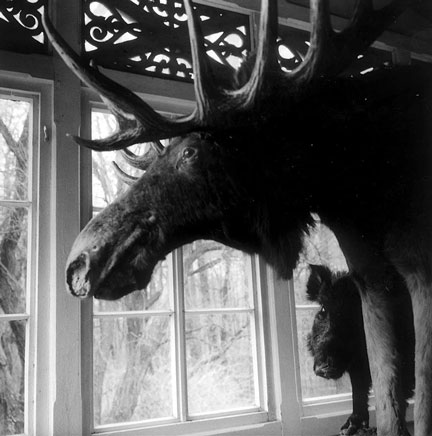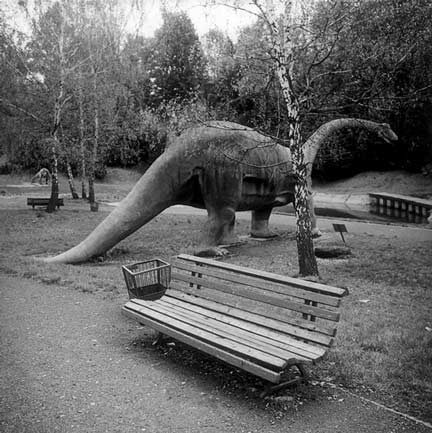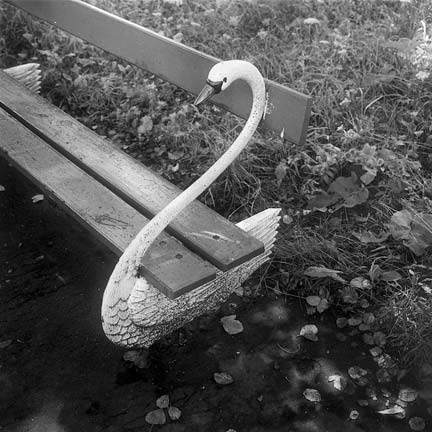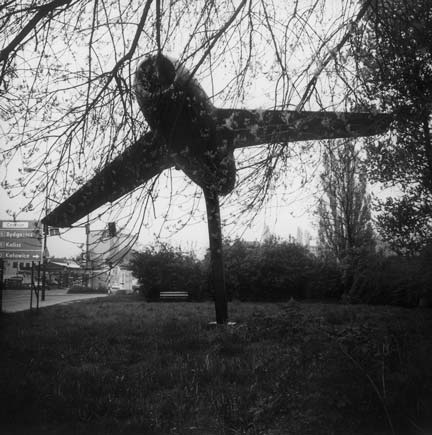September 5 to 29th, 2000
Mala Gallery
8, Zamkowy Sq., Warsaw (Old Town)
Wojciech Prazmowski:
"White and red and black"
Wojciech Prazmowski, from series "White and red and black" (1999). Mala Gallery, Warsaw, September 2000.
NE could expect that the changes that took place in Poland during last years will manifest themselves very quickly in common, everyday circumstances and in city-planning and architecture. Partly it really happened so. Appearance of many towns is constantly changing, new buildings may be seen everywhere. It is especially true in case of big cities, e.g. in Warsaw. But this civilisational acceleration does not progress uniformly. It does not apply to the all regions of Poland in the same way and does not reach to many places that are condemned to stagnation and mere vegetation. It especially applies to so called province. Time stopped there, everything goes in its different, drowsy pace. "Glitter and gloss " do not reach there so quickly as to big urban centres. This peculiar mood or rather glamour of the province which emphasizes so strongly triteness and kitsch do not provoke heated discussions - we take it unintentionally as a constant element ascribed to this places.
Abraham Moles in his well known book on kitsch connects raise and propagation of kitsch to development of middle-class civilisation. Paradoxically broadly understood symptoms of kitsch have survived better in small provincial towns than in great metropolies in which formed schemes of behaviour of the times past have imprinted their material traces in a more strong manner.
Wojciech Prazmowski, from series "White and red and black" (1999). Mala Gallery, Warsaw, September 2000.
Wojciech Prazmowski, from series "White and red and black" (1999). Mala Gallery, Warsaw, September 2000.
Wojciech Prazmowski in order to discover that somewhat dust covered and forgotten world has changed his conventionalities he has been using until now and which were based on investigating the past. He also uses different means now, the means he did not use before. He has decided to bring us closer to this Skansen museum that is slowly falling into oblivion in his "White and red and black" project he has been working upon from the summer months of 1999. One critic has called this project, perhaps too hastily, a "metaphysical reportage". It is a reportage since the way these pictures were executed is charcteristic for this kind of photography. Prazmowski travels to forgotten small towns and hamlets of the east central Poland with a motor-bike he has prepared specially to this purpose. But he do not record there manifestations of everyday life. He is rather registering traces of this life imprinted in peculiar, deprived of any aesthetics products from the not so distant era of so called people's democracy. The protagonists of his discoveries are monuments to airplanes, dinosaurs of concrete on suburban squares, nightmarish benches with swann-shaped backs, stuffed deers, metal animals on merry-go-rounds in abandoned open-air kindergartens. He finds out and records forsaken fragments of provincial rubbish, strange utensils, abandoned and neglected courtyards. Everything on these photographs emanates with helpless and trite provincionalism, almost every picture attacks us with kitsch and ugliness. Rusty fragments of old cars, devastated roundabouts in children's playgrounds, all kinds of monster monuments, elements of so called small architectural objects - all this world we would like to forget quickly but which will last for long physically and will be hard to remove from our subconsciousness as well.
At these pictures, like it happens with most of the works of Wojciech Prazmowski, there are no people. But there is not much of metaphysics either - there is reality lacking any embellishing aesthetics that is painfully attacking us. A cold report behind which merciless decomposition and passing away is lurking - just what has been the main line of Wojciech Prazmowski's art until now. And although there is more of sophisticated, cold and perceptive irony than moody poetry, these modest pictures do contain homesickness and warm human forbearance for madness of exuberant kitsch which may be found not only in the areas to which the photographer reached with his camera.
The "White and red and black" project besides being pure recording of documentary character is also the artist's personal message about durability of some stereotypes manifesting themselves in our surroundings and about the fact, that these surroundings include so many encoded informations concerning ourselves. It proves once again that Wojciech Prazmowski while photographing some stage of lapse of time photographs a certain state of our awareness using very sparing in expresssion and simple registration of reality that surrounds us.
Marek Grygiel
Wojciech Prazmowski, from series "White and red and black" (1999). Mala Gallery, Warsaw, September 2000.
Wojciech Prazmowski, from series "White and red and black" (1999). Mala Gallery, Warsaw, September 2000.
Wojciech Prazmowski
Born in 1949. He photographs from 1969. He studied photography in Brno, Czechoslovakia from 1972 to 1974. He is a lecturer at the Higher Photographic School of the State Film, Theatre and Television Academy in Lodz. Lives in Czestochowa.
Wojciech Prazmowski has commenced his photographic work with documentary photography. Since the late eighties he has been exhibiting in Poland and abroad and already took part in more than 120 exhibitions. He had his individual presentantions in, inter alia, the Striped House Museum in Tokyo, Japan, in the Centre de la Photographie in Pas-de-Calais, France, in the Galleri Image in Aarhus, Danmark, during the festivals of photography FOTOFEST in Houston, USA and FOTOFEIS in Scotland. He has exhibited his works in the most European countries, most recently in Budapest and Beograd and also in USA and Japan.
He has participated in many international exhibitions and projects, inter alia, in exhibition "L'année de l'Est" in Lausanne, Switzerland, "Schnelle Bilder" in Kunstlerhaus" in Vienna, Austrii, Ars Baltica 1 Fototriennial (Schlezwig, Berlin, Dresden, Helsinki, Tallinn, Odense, Warsaw, Poznan).
He published some books, among them "L'ange brisé" in France. Recently a collection of his photographs was published in the series "Polish Photography". His works were presented as a part of the collection of the Centre for the Contemporary Art in the Ujazdowski Palace in Warsaw. He participated twice in the Biennal of Photography in Poznan.
His most recent exhibition "100 photographs" was presented in several Polish cities like Katowice, Sopot, Cracow, Lublin, Wroclaw and Szczecin. In August 2000 there was opened in the Galerie Institut fuer Auslandsbezeihungen e.V his large retrospective exhibition "Fotografien un Objekten". In November 2000 works of Wojciech Prazmowski will be shown at the exhibition "Przemiany" ("Metamorphoses") during the 10th Month of Photography in Bratislava, Slovakia.
The "White and red and black" project was realised by Wojciech Prazmowski in 1999 thanks to grant awarded to him by the Ministry of Culture and Arts of the Republic of Poland.
Prazmowski's previous exhibitions in Mala Gallery:
- 1988 - "The first world exhibition of damaged photographs"
- 1997 - "The very still lifes"
Wojciech Prazmowski, from series "White and red and black" (1999). Mala Gallery, Warsaw, September 2000.
back to FOTOTAPETA's front page
Copyright © 1997-2026 Marek Grygiel / Copyright for www edition © 1997-2026 Zeta-Media Inc.
28 - 10 - 2000





